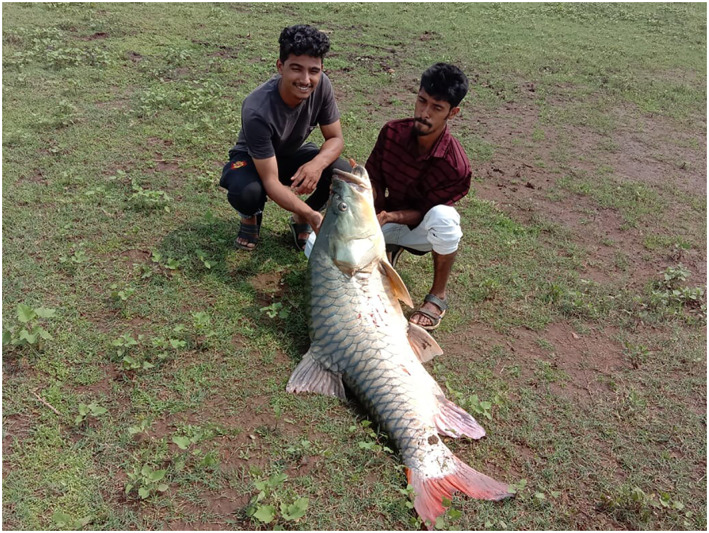Notwithstanding the human suffering caused by COVID‐19, the response (e.g. shelter‐in‐place orders) has yielded some tangible environmental benefits such as substantial improvements in air and water quality (Corlett et al., 2020). In India, this has manifested as heavily polluted rivers now running clear for the first time in decades with, for example, reports suggesting that the quality of the River Ganges has improved sufficiently to support safe bathing.
Hidden beneath these brighter stories however, COVID‐19 is also intensifying pressure on India's aquatic wildlife. In an already poverty‐stricken country, an additional ~12 million are predicted to face extreme poverty as a result of COVID‐19 (World Bank, 2020). Lacking social security, 90% of India's workforce are entirely dependent on daily wages, and are heavily reliant on food supply chains (Reardon et al., 2019) that have been severely disrupted across rural India. With fish (farmed as well as marine‐sourced) and meat forming a primary source of protein for many, its sudden unavailability has resulted in local communities exploiting wild populations, especially freshwater fish.
As most newly recruited fishers lack knowledge on responsible and regulated capture techniques, illegal, indiscriminate and destructive methods are being used that have impacts on all aquatic fauna (e.g. dynamite, poisons). This also includes harvesting species of high extinction risk, exemplified by the endemic hump‐backed mahseer (Tor remadevii, Figure 1), an iconic and critically endangered member of the freshwater megafauna (Pinder, Raghavan, & Britton, in press) symbolic of India's extraordinarily diverse aquatic life. There is increasing evidence that their last remaining giant specimens are being removed from South India's River Cauvery by illegal fishers using a variety of capture methods (Deccan Herald, 2020), pushing them a step closer to extinction. This demonstrates that to understand fully the longer‐term environmental impacts of COVID‐19, there is always a need to look beneath the surface.
FIGURE 1.

Youths with a Critically Endangered hump‐backed mahseer, Tor remadevii, caught from the Harangi Reservoir in Kodagu, Karnataka, India [Photo Credit: Star of Mysore]
Pinder AC, Raghavan R, Britton JR, Cooke SJ. COVID‐19 and biodiversity: The paradox of cleaner rivers and elevated extinction risk to iconic fish species. Aquatic Conserv: Mar Freshw Ecosyst. 2020;30:1061–1062. 10.1002/aqc.3416
REFERENCES
- Corlett, R. T. , Primack, R. B. , Devictor, V. , Maas, B. , Goswami, V. R. , Bates, A. E. , … Cumming, G. S. (2020). Impacts of the coronavirus pandemic on biodiversity conservation. Biological Conservation, 246, 108571 10.1016/j.biocon.2020.108571 [DOI] [PMC free article] [PubMed] [Google Scholar]
- Deccan Herald . (2020). Youth in a fix for catching Mahseer fish, equipment seized. Retrieved from https://www.deccanherald.com/state/mangaluru/youth-in-a-fix-for-catching-mahseer-fish-equipment-seized-832067.html
- Pinder, A. C. , Raghavan, R. , & Britton, J. R. (in press). From scientific obscurity to conservation priority: Research on angler catch rates is the catalyst for saving the hump‐backed mahseer Tor remadevii from extinction. Aquatic Conservation: Marine and Freshwater Ecosystems. [Google Scholar]
- Reardon, T. , Echeverria, R. , Berdegué, J. , Minten, B. , Liverpool‐Tasie, S. , Tschirley, D. , & Zilberman, D. (2019). Rapid transformation of food systems in developing regions: Highlighting the role of agricultural research & innovations. Agricultural Systems, 172, 47–59. 10.1016/j.agsy.2018.01.022 [DOI] [Google Scholar]
- World Bank . (2020). The impact of COVID‐19 (Coronavirus) on global poverty: Why Sub‐Saharan Africa might be the region hardest hit. Retrieved from https://blogs.worldbank.org/opendata/impact-covid-19-coronavirus-global-poverty-why-sub-saharan-africa-might-be-region-hardest


